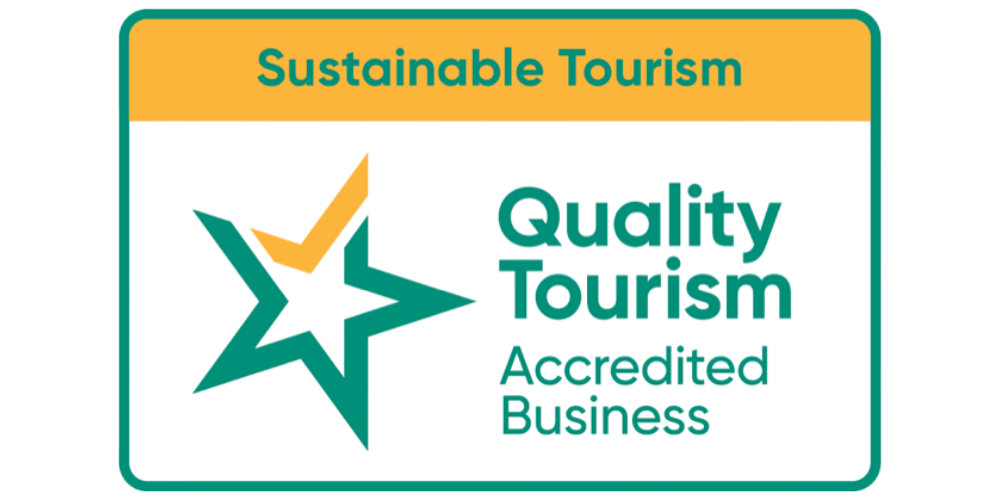The Straightforward Guide to Measuring a Tour’s Carbon Footprint (and Offsetting 200%)
Curious how a tour’s climate impact is measured—properly—without greenwash, mystery math, or missing flights? This guide walks through a transparent, conservative (“high-estimate”) method that covers Scopes 1–3, includes guest travel to and from the start point, and finishes with a clear 200% offset commitment. It’s designed so any responsible tour provider—or curious traveller—can look deepering into their tours emissions.
Why “CO₂e,” and why the high-estimate approach?
CO₂e (carbon-dioxide equivalent) bundles all major greenhouse gases into one comparable unit. Different gases warm the planet differently and for different lengths of time; CO₂e lets us speak one language.
High-estimate means leaning conservative when data is patchy—using reputable factors and slightly “rounding up” so totals don’t understate reality. This is especially important for aviation, where non-CO₂ effects (like contrails) add warming beyond tailpipe CO₂. Accounting for those ensures results are robust, not optimistic.
What this is built on (the boring—but crucial—bit)
The method aligns with the GHG Protocol and uses current conversion factors from UK DEFRA/BEIS, Australia’s National Greenhouse Accounts (NGA), US EPA, and HCMI for hotels.
Zero Trace Tours — CO₂e Measurement & Reporting Template (High-Estimate Method)
Purpose (what this report does)
Estimate total greenhouse gas emissions (CO₂e) per tour using a conservative method across Scopes 1–3, then offset 200% to ensure a net-positive contribution to landscapes. Methodology aligns with GHG Protocol and uses up-to-date emission factor sets. (References listed at the end.)
1) Tour Header (the who/what/where)
Fill this in for each departure so every report is traceable.
-
Tour name:
-
Location / Region:
-
Duration / Season:
-
Group size (max / actual):
-
Start / Finish points:
-
Report period:
2) Scope & Boundaries (what’s included—and why)
-
Scope 1 (direct): On-tour fuel use (4WD, boats, generators).
Why? These are emissions directly burned for the tour. -
Scope 2 (energy): Purchased electricity billed directly to the tour (rare; commonly captured via hotels in Scope 3).
Why? If you pay a power bill for the tour, count it. -
Scope 3 (value chain):
-
Guest travel to/from start point (see Feeder Hub Logic)
-
Supplier vehicles (buses/coaches), ferries, rail
-
Accommodation (room-nights)
-
Meals & catering (if provided), water & waste handling
-
Hire gear & consumables where material
-
Guide/staff travel specifically for this tour (if not already counted in Scope 1/2)
Why? Most tour emissions live here—especially flights and hotels.
-
-
Excluded: Long-lived capital goods (e.g., vehicle manufacture). If material, allocate separately as a note.
Why? Those are depreciated across many years and tours; treat them transparently but separately.
3) Data You Provide (per departure)
Collect these once; repeat for every departure:
-
Guests: headcount; starting city if known
-
Transport on tour: vehicle types, km; vessel hours or fuel; rail/coach segments
-
Accommodation: property names, room-nights (by type)
-
Activities: boats, scenic flights, fuel-powered equipment (hours or litres)
-
Meals included: number by meal type (breakfast/lunch/dinner)
-
Waste & water (if tracked): bags or kg; m³ water (optional)
-
Staff travel to/from start: mode, distance (if not already counted)
Tip: Build a one-page ops sheet per departure. If a supplier can’t give fuel or meter data, note that—and use the conservative defaults next.
4) Conservative Defaults (High-Estimate policy)
Use these only when you don’t have measured data.
4.1 Flights (guest travel to/from start)
-
Method: Distance-based factors with Well-to-Tank (WTT) + non-CO₂ effects via Radiative Forcing (RF).
-
RF multiplier (default): 1.9 (between UK guidance ~1.7 for certain methods and strict tools up to ~2.0). Choose one value, disclose it, and apply consistently.
-
Seat class: Economy.
-
Connections: Include realistic routing and one extra LTO (landing/take-off) if typical.
-
ICAO note: ICAO’s calculator outputs CO₂ only; add RF separately.
Why this matters: RF accounts for warming beyond CO₂ at altitude. Omitting it can under-report by a meaningful margin.
4.2 Road transport
Use passenger-km factors for coach/minibus/car with WTT included. If occupancy is unknown, assume lower occupancy (conservative). Prefer DEFRA 2024/2025 or Australia NGA 2024.
4.3 Marine (boats)
Best: fuel-based (diesel/petrol litres × factor including WTT). If fuel is unknown, use hours × typical burn for that vessel class and cite the source.
4.4 Accommodation
Calculate per room-night using HCMI or property-provided HCMI figures. If missing, use regional defaults and cite.
4.5 Meals
If meals are included, apply conservative per-meal factors (regional or DEFRA/EPA food categories). If meals are not included in the tour, don’t count off-tour dining.
4.6 Waste & Water
Use national factors (e.g., Australia NGA 2024; EPA Hub in the US). If a factor range is given, use the upper bound.
4.7 Electricity (if separately metered)
Apply the country/regional grid factor (e.g., NGA 2024; EPA eGRID). Include T&D losses where guidance supports it.
5) Feeder Hub Logic (counting guest travel fairly)
When actual guest origin cities aren’t known, include return flights from a reasonable nearby major hub. This sets a consistent baseline so flights aren’t “forgotten.”
Rules
-
Regional Australia:
-
Hobart starts → Melbourne (MEL)
-
Perth starts → Melbourne (MEL) (if data shows Sydney is more common/longer, use SYD for conservatism)
-
Alice Springs/Uluru starts → Sydney (SYD) or Melbourne (MEL) (choose the longer if aiming for a higher bound)
-
-
SE Asia islands: via Singapore (SIN) or Kuala Lumpur (KUL); if routing commonly requires it, Dubai (DXB)
-
Iceland: London (LHR) by default; sanity-check Paris (CDG)
-
Europe (intra-EU): nearest tier-1 hub (LHR/FRA/CDG/AMS/MAD)
-
Africa: nearest regional hub (JNB/ADD/DOH/DXB corridor dependent)
-
Americas: nearest tier-1 hub (NYC/YYZ/LAX/MIA/GRU/MEX)
-
Oceania (NZ): Auckland (AKL)
Why this matters: It avoids under-counting when guest data is incomplete. Where two hubs are equally plausible, pick the longer routing to stay conservative—and apply WTT + RF.
6) Emissions Inventory (the working table)
This is the arithmetic backbone. Keep it tidy, source every factor, and note any assumptions.
| Category | Activity data | Emission factor source | Calc | CO₂e |
|---|---|---|---|---|
| Guest flights (return) | [Hub ↔ Start], distance (km), connections | DEFRA 2025 p-km (add RF 1.9), or ICAO CO₂ + RF | km × kgCO₂e/p-km × RF | ___ kg |
| On-tour road | Vehicle km × pax (or fuel litres) | DEFRA 2024/2025 or NGA 2024 | p-km × EF (or L × EF) | ___ kg |
| Boats | Fuel litres or hours | DEFRA 2024/2025 | L × EF (WTT+comb.) | ___ kg |
| Rail/Ferry | p-km | DEFRA 2024/2025 | p-km × EF | ___ kg |
| Accommodation | Room-nights by type | HCMI or property data | nights × kgCO₂e/night | ___ kg |
| Meals (incl.) | # breakfasts/lunches/dinners | EPA/DEFRA food EFs (if used) | meals × EF | ___ kg |
| Waste/Water | kg waste / m³ water | NGA 2024 / EPA Hub | qty × EF | ___ kg |
| Staff travel | Mode × distance | Same as guest methods | distance × EF | ___ kg |
| Other (specify) | ___ kg |
Subtotal (tour-related): ___ kg CO₂e
High-estimate uncertainty uplift (add +10% where primary data is missing): ___ kg CO₂e
Estimated total (per guest): ___ kg CO₂e / guest (tour total ÷ guests)
Estimated total (per tour): ___ kg CO₂e
Why the +10%? It’s a guardrail when suppliers can’t provide meter/fuel data. Call it out so readers see the honesty.
7) Results (make it easy to grasp)
-
Per guest: __ kg CO₂e
-
Per tour (group): __ t CO₂e
-
What gets offset: 200% of total = __ t CO₂e retired as high-quality, independently verified nature-based credits (see Offset Ledger for project IDs, registries, and retirement links).
Heads-up: Many calculators show CO₂ only for flights. This method adds non-CO₂ impacts via RF, which is why numbers may look higher—and more honest.
8) Assumptions & Choices (publish them)
-
Flights: Distance-based factors with WTT + RF 1.9; economy seating. Some official guidance references 1.7 for specific methods; reputable tools vary ~1.7–2.0. Disclose and be consistent.
-
Road/boat: WTT included where available; conservative occupancy if unknown.
-
Accommodation: HCMI or supplier-provided; regional defaults if missing.
-
Waste/water: Latest national factors (AU: NGA 2024; US: EPA Hub).
-
Uncertainty uplift: +10% on categories without primary meter/fuel data.
-
Boundaries: Only included tour services are counted (no extra promises).
9) Local Insights (optional context)
Add 3–5 area-specific facts (geology, ecology, cultural respect, safety/seasonality), cited and non-promissory.
Example: “Ningaloo is a fringing reef close to shore; cyclone season typically peaks late summer.”
Why include this? It educates without over-claiming and helps readers understand environmental context.
10) Offset Plan (200%)
-
Offset volume: 2× the estimated tour emissions (per departure).
-
Credit criteria: Independently verified, additional, durable—prefer restoration-aligned projects. The Offset Ledger records project name, ID, vintage, registry, and retirement certificate link.
-
Timing: Credits retired within 30 days of tour completion; ledger updated quarterly.
Why 200%? Over-compensation builds a margin of safety and funds more restoration than the tour emits—net-positive by design.
11) Versioning & Updates (keep it fresh)
-
Factor sets are reviewed annually or sooner if guidance changes.
-
Report includes factor versions used, e.g.:
-
DEFRA/BEIS 20XX conversion factors
-
Australia NGA 2024
-
HCMI hotel factors (property/regional)
-
EPA Emission Factors Hub (for US waste/water/electricity as applicable)
-
Quick How-To (your per-tour workflow)
-
Fill Sections 1–3 (basics + raw activity data).
-
Apply Section 4 defaults only where primary data is missing.
-
Choose a Feeder Hub (Section 5) and calculate guest return flights.
-
Complete the Inventory table and add +10% uncertainty where needed.
-
Publish Results + Assumptions + Local Insights + References.
-
Record the 200% offset in the Offset Ledger (with links).
Friendly nudge: Build this into your ops checklist so the report is automatic, not a scramble.
References
-
DEFRA/BEIS 2024–2025 Conversion Factors (transport, fuels; RF guidance; WTT): UK Government & methodology paper.
Greenhouse gas reporting: conversion factors 2024 • 2024 methodology • 2025 methodology -
GHG Protocol Corporate Standard (Scopes 1–3 boundaries). GHG Protocol FAQs
-
Australia National Greenhouse Accounts (NGA) Factors 2024 (national emission factors). DCCEEW
-
ICAO Carbon Emissions Calculator (CO₂ only; add RF externally). ICAO Help
-
Hotel Carbon Measurement Initiative (HCMI) (room-night methodology). WSHA HCMI
-
US EPA Emission Factors Hub (waste/water; regional electricity). EPA Hub
-
UK DfT Journey Emissions Guidance (distance/mode comparison methodology). DfT methodology
-
Context on RF multipliers (range used in practice). atmosfair calculator paper
Glossary (keeping the jargon honest)
-
CO₂e: “Carbon-dioxide equivalent.” A single unit that includes CO₂ and other greenhouse gases.
-
Scopes 1–3: Accounting buckets: direct fuel (1), purchased energy (2), value-chain (3).
-
WTT (Well-to-Tank): Emissions from producing and transporting fuels before they’re burned.
-
RF (Radiative Forcing): A multiplier to reflect extra warming from aviation beyond CO₂ (e.g., contrails).
-
p-km (passenger-kilometre): One passenger travelling one kilometre—handy for shared transport.
-
Room-night: One room occupied for one night—used to calculate hotel impacts.




